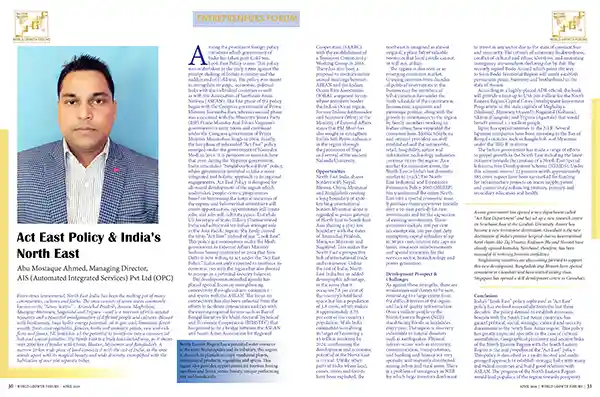
Abu Mostaque Ahmed,
Managing Director,
AIS (Automated Integrated Services) Pvt Ltd (OPC)
WGF World’s Top Nation Builders
WGF Entrepreneurs Forum

World Growth Forums Magazine April 2020
Act East Policy & India’s North East

By Abu Mostaque Ahmed
Managing Director,
AIS (Automated Integrated Services) Pvt Ltd (OPC)
Abu Mostaque Ahmed is from India.
From times immemorial, North East India has been the melting pot of many communities, cultures and faiths. The area consists of seven states commonly known as the “Seven Sisters” – Arunachal Pradesh, Assam, Meghalaya, Manipur, Mizoram, Nagaland and Tripura – and is a reservoir of rich natural resources and a beautiful amalgamation of different people and cultures. Blessed with biodiversity, huge hydro-energy potential, oil & gas, coal, limestone, forest wealth, fruits and vegetables, flowers, herbs and aromatic plants, rare and rich flora and fauna, NE India has all the potential to transform into a commercial hub and tourist paradise. The North East is a truly land-locked area, as it shares over 2000 km of border with China, Bhutan, Myanmar and Bangladesh. A narrow 20 km wide piece of land connects it with the rest of India, as the area stands apart with its magical beauty and wide diversity, exemplified with the habitation of over 166 separate tribes.
Look East Policy
Among the prominent foreign policy initiatives which government of India has taken post-Cold war, Look East Policy is one. This policy was undertaken in the early 1990s against the prompt shaking of Indian economy and the sudden end of Cold war.
The policy was meant to strengthen strategic, economic, political links with the individual countries as well as with the Association of Southeast Asian Nations (ASEAN). The first phase of the policy began with the Congress government of Prime Minister Narsimha Rao; whereas second phase was associated with the Bharatiya Janata Party (BJP) Prime Minister Atal Bihari Vajpayee’s government in early 2000s and continued under the Congress government of Prime Minister Manmohan Singh in 2004. Finally, the last phase of rebranded “Act East” policy emerged under the government of Narendra Modi in 2014.
It is pertinent to mention here that even during the Vajpayee government, India articulated “Neighbourhood First” policy, where government intended to take a more integrated and holistic approach to its regional engagements. Act East Policy is designed for all-round development of the region which undertakes ‘people-centric programmes based on harnessing the natural resources of the region, and believes that investment will create opportunities, opportunities will create jobs, and jobs will cultivate peace.
Erstwhile US Secretary of State, Hillary Clinton visited India and advocated for India’s stronger role in the Asia Pacific region. She firstly coined the term “Act East” instead of just “Look East”.
This policy got momentum under the Modi government as External Affairs Minister Sushma Swaraj confirmed in 2014 that New Delhi is now willing to act under the “Act East Policy”. India not only expected to reinforce its economic ties with the region but also desired to emerge as a potential security balancer.
The development-intended agenda has placed special focus on strengthening connectivity through culture, commerce and sports with the ASEAN. The focus on connectivity has also been reflected from the efforts to facilitate connections and ties with the existing regional forums such as Bay of Bengal Initiative for Multi-Sectoral Technical and Economic Cooperation (BIMSTEC) that has proved to be a bridge between the ASEAN and South Asian Association for Regional Cooperation (SAARC) with the establishment of a Transport Connectivity Working Group in 2016.
There has also been a proposal to institutionalize annual meetings between ASEAN and the Indian Ocean Rim Association (IORA), a regional forum whose members border the Indian Ocean region.
Former Indian Ambassador and Secretary (West) in the Ministry of External Affairs states that PM Modi has also sought to strengthen India’s Soft Power influence in the region through the promotion of Yoga and revival of the ancient Nalanda University.
North Eastern Region has a potential water resource in the river Brahmaputra and its tributary, this region is also rich in plantation crops, medicinal plants, horticultural products, vegetables and spices. This region also provides opportunities for tourism having rare flora and fauna, scenic beauty, unique performing arts and handicrafts.
Click Here to Access More World Leaders…
Opportunities
North East India shares borders with Nepal, Bhutan, China, Myanmar and Bangladesh creating a long boundary of 4500 km long international border.
Myanmar alone is regarded as prime gateway of North East to South East Asia sharing a 1643 km boundary with the states of Arunachal Pradesh, Manipur, Mizoram and Nagaland. This makes the North East a prospective hub of international trade and commerce.
Unlike the rest of India, North East India has an added demographic advantage, in the sense that it occupies 7.8 per cent of the country’s total land space but has a population of 3.8 crore, which makes it approximately 3.73 per cent of the country’s population.
With India committed to realizing its target of becoming a $5 trillion economy by 2024, accelerating the development and economic potential of the North East is critical.
Unlike other parts of India where land, coasts, rivers and forests have been exploited, the northeast is imagined as almost virginal, a place full of valuable resources that local people cannot, or will not, utilize.
The region is also seen as an emerging consumer market. Growing incomes from decades of political reservations in the bureaucracy for members of tribal communities under the Sixth schedule of the constitution, bureaucratic expansion and patronage politics, along with the growth in remittances to the region by family members working in Indian cities, have expanded the consumer base.
Mobile telephone and internet providers are well established and the automobile, retail, hospitality, airline and information technology industries continue to eye the region. As a market for consumer items, the North East is India’s last domestic market to ‘crack’. The North East Industrial and Investment Promotion Policy 2007 (NEIIPP) has transformed the entire North East into a special economic zone.
It provides major incentives (mostly over a 10-year period) for new investments and for the expansion of existing investments. These incentives include 100 per cent tax exemption, 100 per cent duty exemption, capital subsidies of up to 30 per cent, interest rate caps on loans, insurance reimbursements and special incentives for the services sector, biotechnology and power generation.
Assam government has opened a new department called “Act East Department” and has set up a new research centre on Southeast Asia at the Gauhati University. Assam has become a new investment destination. Guwahati is the new destination of India’s premier hospital chains. International hotel chains like Taj Vivanta, Radisson Blu and Novotel have already opened branches. Northeast, therefore, has been successful in restoring business confidence.
Neighboring countries are also coming forward to support this new development. Bangladesh and Bhutan have opened consulates in Guwahati and have started issuing visas. Singapore has opened a skill development centre in Guwahati.
Development Prospect & Challenges
As against these strengths, there are weaknesses and threats to be sure, emanating to a large extent from the difficult terrain of the region and lack of quality infrastructure.
Over a million people in the North Eastern Region (NER) stand facing floods or landslides every year. The region is also very vulnerable to natural disasters such as earthquakes. Physical infrastructure such as electricity, communication, transportation, and banking and finance are very sporadic and unevenly distributed among urban and rural areas.
There is a problem of insurgency in NER for which large investors don’t want to invest in any sector due to the state of constant fear and insecurity. The cobweb of economic backwardness, conflict of cultural and ethnic identities, and mounting insurgency are somehow declining day by day.
The recently signed Bodo Accord which paves the way to form Bodo Territorial Region will surely establish permanent peace, harmony and brotherhood in the state of Assam.
According to a highly-placed ADB official, the bank will provide a loan up to US$ 200 million for the North Eastern Region Capital Cities Development Investment Programme in the state capitals of Meghalaya (Shillong), Mizoram (Aizawl), Nagaland (Kohima), Sikkim (Gangtok) and Tripura (Agartala) that would benefit around 1.2 million people.
Japan has special interests in the NER. Several Japanese companies have been investing in the Bay of Bengal countries such as Bangladesh and Myanmar under the ‘BIG B’ initiative.
The Indian government has made a range of efforts to propel growth in the North East including the latest initiative towards the creation of a North East Special Infrastructure Development Scheme (NESIDS). Under this scheme, around 22 projects worth approximately 885 crore rupees have been earmarked for funding for infrastructure projects on water supply, power and connectivity enhancing tourism, primary and secondary education and health.
Conclusion
India’s “Look East” policy rephrased as “Act East” policy has evolved successfully from the last three decades. The policy devised to establish economic bounds with the South East Asian countries, has gained political, social, strategic, cultural and security dimensions in the South East Asian region.
This policy has greatly impacted specially in the case of cultural assimilation. Geographical proximity and ancient links of the North Eastern Region with the South Eastern Region is the real propeller of the “Act East” policy.
This policy is described as a multi-faceted and multipronged approach to establish strategic links with many individual countries and build good relations with ASEAN. The progress of the North Eastern Region would lead populace of the region towards prosperity.




